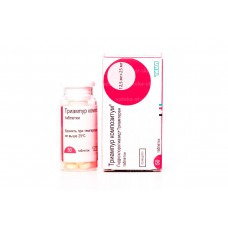Expiration date: 05/2028
Type and form of issue:
Tablets. 1 tablet contains:
active substance:
triamteren 25 mg
hydrochlorothiazide 12, 5 mg
excipients: lactose monohydrate-63 mg potato starch-20, 725 mg povidone K25-3, 9 mg silicon colloidal dioxide-0, 975 carboxymethyl starch sodium-2, 6 mg magnesium stearate-1, 3 mg
50 PCs. in bottles of colorless glass with a white cap made of LDPE with the embossed inscription " AWD " in a pack of cardboard 1 bottle.
Description of the dosage form:
Yellow, round, flat tablets with a risk on one side and with beveled edges, smooth surfaces, solid edges and the same appearance.
Indications:
Arterial hypertension, edematous syndrome of various Genesis (in chronic heart failure, liver and kidney diseases).
Maintenance therapy in the treatment of heart failure with glycosides in patients with a tendency to form edema.
Contraindications:
Hypersensitivity (including to sulfonamides), renal failure, anuria, acute glomerulonephritis, severe liver function disorders (precoma and hepatic coma), non-correctable electrolyte metabolism disorders: hypokalemia, hyperkalemia, hypercalcemia, hyponatremia hypovolemia.
Use during pregnancy and lactation:
Contraindicated during pregnancy. Breast-feeding should be stopped during treatment.
Side effect:
From the nervous system and sense organs: sometimes-ataxia, drowsiness, dry mouth, thirst, fatigue, headache, nervousness rarely-weakly expressed visual disorders, deterioration of existing myopia, reduced tear secretion, etc.
From the cardiovascular system and blood (hematopoiesis, hemostasis): sometimes-ECG changes, palpitations, lowering blood PRESSURE, orthostatic hypotension, changes in the blood picture, etc.
From the digestive tract: nausea, vomiting, diarrhea, sometimes — pain in the epigastrium, adinamia of the intestinal smooth muscle, partial intestinal obstruction in some cases — jaundice, hemorrhagic pancreatitis, inflammation of the gallbladder (in the presence of gallstone disease).
From the side of metabolism: violation of electrolyte balance, water metabolism, metabolic acidosis, increased cholesterol, triglycerides, glucose, uric acid in the blood dehydration, hypovolemia.
From the musculoskeletal system: lethargy of skeletal muscles, muscle tension, convulsions of the calf muscles.
Allergic reactions: in rare cases-redness and itching of the skin, urticaria, erythematosis, exanthema, fever.
Drug interaction:
Antihypertensive drugs (especially ACE inhibitors), diuretics, barbiturates, phenothiazines, tricyclic antidepressants, vasodilators enhance the hypotensive effect of NSAIDs — weaken.
Indomethacin with simultaneous use reduces glomerular filtration, colestyramine reduces absorption, potassium salts, potassium-sparing diuretics, ACE inhibitors increase the risk of hyperkalemia, glucocorticoids and laxatives — hypokalemia.
It weakens the action of antidiabetic, antiopodagric agents, noradrenaline and epinephrine, increases the cardio-and neurotoxic effect of lithium, side effects of salicylates on the Central nervous system increases the effect of curare-like muscle relaxants, cardiac glycosides (in the presence of potassium and/or magnesium deficiency in the body), cytostatics (on the bone marrow) reduces the excretion of quinidine.
Dosage and administration:
Inside, after eating, without chewing and drinking a small amount of water.
Edematous syndrome: the initial dose is determined by the severity of violations of water-electrolyte metabolism and is usually 1 table. 2 times a day after meals, then it is possible to increase the dose to the maximum daily dose (4 table.): 2 tables. after Breakfast and 2 tables. after dinner.
When compensating for edema, they switch to maintenance therapy for 1-2 tables. in 1-2 days.
Arterial hypertension: the initial dose is 1 tablespoon. per day (in the morning, after Breakfast), then the dose is gradually increased. The maximum daily dose is 4 tablets. In patients with impaired renal function (creatinine Cl-30-50 ml / min), the maximum daily dose is 1 table.


